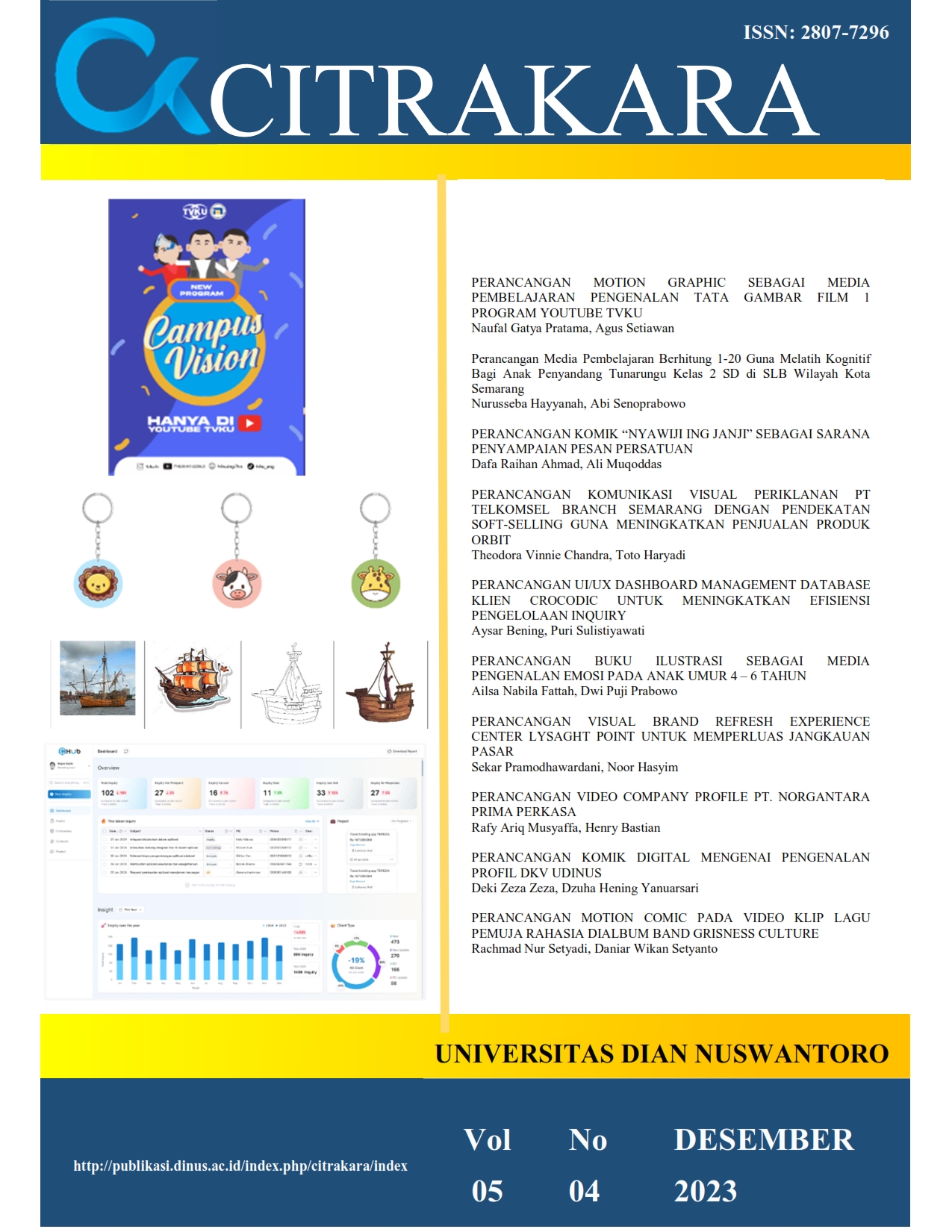PERANCANGAN BUKU ILUSTRASI SEBAGAI MEDIA PENGENALAN EMOSI PADA ANAK UMUR 4 – 6 TAHUN
DOI:
https://doi.org/10.33633/ctr.v5i4.11032Abstract
Pengenalan emosi pada anak usia dini khususnya berumur 4 – 6 tahun masih dianggap sepele bagi orangtua. Para orangtua cenderung tidak peduli dan lebih memilih melakukan metode screen time untuk mengalihkan emosi anak mereka. Pemilihan media harus berhati-hati agar media sesuai dan nyaman untuk anak sehingga menciptakan tumbuh kembang sosial emosional yang baik dan positif, salah satunya melalui buku ilustrasi anak yang menarik dan interaktif. Perancangan ini menggunakan metode penelitian kualitatif melalui observasi, wawancara, dan studi pustaka. Analisis data menggunakan 5W+1H dengan metode perancangan pra-produksi, produksi, dan pasca produksi. Perancangan ini menghasilkan media utama buku ilustrasi anak dan media pendukung yaitu flash card, stiker satuan, stiker set, gantungan kunci, kipas karakter, dan pouch kecil. Kata Kunci: anak usia dini, emosi, ilustrasi, media pembelajaranReferences
American Academy of pediatrics. (2022). Supporting emotional, behavioral needs of children in the pandemic: Updated guidance. 129: e827- e841
Apsari, D., & Guna Putra, W. T. (2021). Memahami Ekspresi Emosional Melalui Bahasa Visual Dalam Buku Cergam Anak “Little Grey.” Desain Komunikasi Visual, Manajemen Desain Dan Periklanan (Demandia), 6(1), 1. https://doi.org/10.25124/demandia.v6i1.2743
Badan Pusat Statistik Indonesia. (12 Desember 2023). Profil Anak Usia Dini 2023. Diakses pada 2 Februari 2024, dari
https://www.bps.go.id/id/publication/2023/12/12/e9b0a9a0adcffefb137e0d0d/profil-anak-usiadini-2023.html
Chan, T. K. S., Wong, S. W. L., Wong, A. M. Y., & Leung, V. W. H. (2019). The Influence of Presentation Format of Story on Narrative Production in Chinese Children Learning English-asa-Second-Language: A Comparison Between Graphic Novel, Illustration Book and Text. Journal of Psycholinguistic Research, 48(1), 221–242. https://doi.org/10.1007/s10936-018-9600-9
Coyne, S. M., Shawcroft, J., Gale, M., Gentile, D. A., Etherington, J. T., Holmgren, H., & Stockdale, L. (2021). Tantrums, toddlers and technology: Temperament, media emotion regulation, and problematic media use in early childhood. Computers in Human Behavior, 120(February), 106762. https://doi.org/10.1016/j.chb.2021.106762
Domoff, S. E., Harrison, K., Gearhardt, A. N., Gentile, D. A., Lumeng, J. C., & Miller, A. L. (2019). Supplemental Material for Development and Validation of the Problematic Media Use Measure: A Parent Report Measure of Screen Media “Addiction” in Children. Psychology of Popular
Media Culture, 8(1), 2–11. https://doi.org/10.1037/ppm0000163.supp
Gleason, M. M., Goldson, E., & Yogman, M. W. (2016). Addressing Early Childhood Emotional and Behavioral Problems. Pediatrics, 138(6). https://doi.org/10.1542/peds.2016-3025
Hare, M. M., Garcia, A. M., Hart, K. C., & Graziano, P. A. (2021). Intervention response among preschoolers with ADHD: The role of emotion understanding. Journal of School Psychology, 84 (January 2020), 19–31. https://doi.org/10.1016/j.jsp.2020.11.001
Hijriati, H. (2017). Peranan Dan Manfaat Ape Untuk Mendukung Kreativitas Anak Usia Dini. Bunayya : Jurnal Pendidikan Anak, 3(2), 59. https://doi.org/10.22373/bunayya.v3i2.1699
Janottama, I. P. A., & Putraka, A. N. A. (2017). Gaya Dan Teknik Perancangan Ilustrasi Tokoh Pada Cerita Rakyat Bali. Segara Widya : Jurnal Penelitian Seni, 5(November), 25–31. https://doi.org/10.31091/sw.v5i0.189
Levine, L. E., Waite, B. M., Bowman, L. L., & Kachinsky, K. (2019). Mobile media use by infants and toddlers. Computers in Human Behavior, 94(September 2018), 92–99. https://doi.org/10.1016/j.chb.2018.12.045
Moon, D. S., & Bahn, G. H. (2022). The Concept of Synchronization in the Process of SeparationIndividuation Between a Parent and an Adolescent. Journal of the Korean Academy of Child and Adolescent Psychiatry, 33(2), 41–47. https://doi.org/10.5765/jkacap.220003
Naughton, A. M., Maguire, S. A., Mann, M. K., Lumb, R. C., Tempest, V., Gracias, S., & Kemp, A. M. (2013). Emotional, behavioral, and developmental features indicative of neglect or emotional abuse in preschool children a systematic review. JAMA Pediatrics, 167(8), 769–775. https://doi.org/10.1001/jamapediatrics.2013.192
Ndari, S. S., Vinayastri, A., & Masykuroh, K. (2019). Metode Perkembangan Sosial Emosi Anak Usia Dini. Edu Publisher. Rakhmawati, R. (2022). Alat Permainan Edukatif (APE) untuk Meningkatkan Perkembangan Sosial
Emosional Anak Usia Dini. Bulletin of Counseling and Psychotherapy, 4(2), 381–387. https://doi.org/10.51214/bocp.v4i2.293
Ratnasari, E. M., & Zubaidah, E. (2019). Pengaruh Penggunaan Buku Cerita Bergambar Terhadap Kemampuan Berbicara Anak. Scholaria: Jurnal Pendidikan Dan Kebudayaan, 9(3), 267–275. https://doi.org/10.24246/j.js.2019.v9.i3.p267-275
Shin, M., & Kemps, E. (2020). Media multitasking as an avoidance coping strategy against emotionally negative stimuli. Anxiety, Stress and Coping, 33(4), 440–451. https://doi.org/10.1080/10615806.2020.1745194
Walidin, W., Saifullah, & ZA, T. (2020). Metodologi Penelitian Kualitatif Dan Grounded Theory. 8(January), 274–282.
Downloads
Published
Versions
- 2024-07-02 (3)
- 2024-07-02 (2)
- 2024-07-02 (1)
How to Cite
Issue
Section
License
Copyright (c) 2024 Ailsa Nabila Fattah, Dwi Puji Prabowo

This work is licensed under a Creative Commons Attribution-ShareAlike 4.0 International License.
Karya ini dilisensikan di bawah CC BY-SA 4.0





